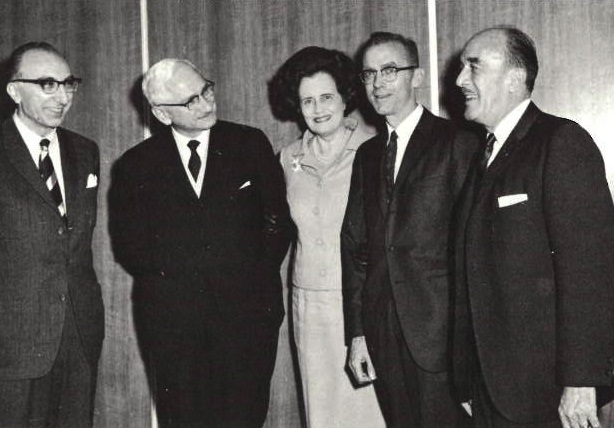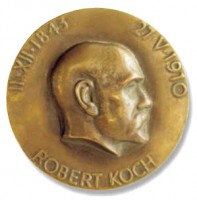By Richard Jason Sookoor, Sabin Student Assistant
For the month of August, we will continue our series on the Awards and Honors Dr. Sabin received during his lifetime. This week we take a look at arguably Dr. Sabin most influential achievement: the live, oral polio vaccine. Or rather, we observe the accolades Dr. Sabin received for developing the vaccine. Despite the development of previous polio vaccines, Dr. Sabin’s vaccine was ultimately chosen for worldwide distribution after large scale clinical trials were performed. Not only did this help lead to the eradication of polio in the Western and developing world, but it also helped pave the way for the molding the public perception regarding the importance of vaccination.
One of the earliest major organizations to recognize Dr. Sabin’s polio vaccine was the Robert Koch Foundation.[1] The organization, founded by Dr. Robert Koch and partially funded by Andrew Carnegie, is the one of the most prestigious institutions in Germany.[2] The Gold Medal prize for 1962 was shared among Dr. Sabin, Dr. Jonas Salk, and Dr. John Enders.[2] The Gold Medal prize is given for outstanding and internationally recognized achievements in science. Despite sharing the prize with a competitor (Dr. Salk), Dr. Sabin was rather pleased to receive the recognition.

Dr. Sabin accepting the Lasker Award for Clinical Medical Research in 1965. Dr. Sabin is second from the left, and Mrs. Lasker is in the center.
In 1965, Dr. Sabin was awarded the Lasker Award for Clinical Medical Research.[3] Perhaps the most significant honor, the Lasker Award (occasionally referred to as “America’s Nobel Prize”[4]) is given to individuals who have made a substantial contribution to medicine and science. The award consists of a $10,000 honorarium, an engraved citation, and a replica of the winged victory of Samothrace.[5] Along with worldwide recognition within the community, the award signifies the acceptance of Dr. Sabin’s vaccine over competing vaccines.
The recognition of Dr. Sabin’s vaccine wasn’t strictly limited to medical organizations, as proven in 1969. In January of 1969, two Vice Consuls from the Japanese consulate visited Cincinnati to present Dr. Sabin with the Order of The Sacred Treasure of Japan, a national honor of Japan.[6] The ceremony was small and attended by the Consuls and Dr. Sabin’s Family in the office of the President of the University of Cincinnati. Interestingly, Dr. Sabin had received a few congratulatory letters from his friends and colleagues in Japan months before receiving notification from the government concerning the honor. [7] Recommendations for the award were made by faculty at the Japan Live Polio Vaccine Laboratory, an institution Dr. Sabin visited a few years prior. Of particular note, the last acute outbreak of poliomyelitis was in 1960. The adoption of Dr. Sabin’s vaccine a few months later led to a decline and ultimately the virtual eradication of polio in Japan.[8]
These are just a handful of awards recognizing Dr. Sabin’s live, oral polio vaccine. Hospitals, medical centers, and even roads around the world were named in honor of Dr. Sabin, primarily in appreciation for his vaccine. Considering how many people lived to see the horrors of polio and then the eventual eradication of the disease due to an accessible, easy-to-use vaccine, the admiration for the man who developed the vaccine is substantial. Next week, we’ll continue our series and take a look at other honors Dr. Sabin received later in life.
References
[1] Found in Series 11 — Professional and Personal Engagements, Sub-series — Awards and Honors, Box 2, Folder 11 — Robert Koch Award, 1963.
[2] Hilgers, V. (n.d.). Robert-Koch-Stiftung – A warm welcome. Retrieved from http://www.robert-koch-stiftung.de/index.php?article_id=1&clang=1
[3] Found in Series 11 — Professional and Personal Engagements, Sub-series — Awards and Honors, Box 2, Folder 22 — Lasker Award, 1965.
[4] Lasker Award – Wikipedia. (2012, 06 07). Retrieved from http://en.wikipedia.org/wiki/Lasker_Award
[5] Letter from Alice Fordyce to Dr. Sabin, dated May 27, 1965. Found in Series 11 — Professional and Personal Engagements, Sub-series — Awards and Honors, Box 2, Folder 22 — Lasker Award, 1965.
[6] Letter from Dr. Sabin to Minoru Matumoto, dated January 15, 1969. Found in Series 11 — Professional and Personal Engagements, Sub-series — Awards and Honors, Box 3, Folder 16 — Order of the Sacred Treasure of Japan, 1968.
[7] Letters colleagues to Dr. Sabin, dated October 1968 to January 1969. Found in Series 11 — Professional and Personal Engagements, Sub-series — Awards and Honors, Box 3, Folder 16 — Order of the Sacred Treasure of Japan, 1968.
[8] Matsuura, K. (2000, 11). Assessment of poliovirus eradication in japan: Genomic analysis of polioviruses isolated from river water and sewage in Toyama prefecture. Retrieved from http://www.ncbi.nlm.nih.gov/pmc/articles/PMC92424/
In 2010, the University of Cincinnati Libraries received a $314,258 grant from the National Endowment for the Humanities (NEH) to digitize the correspondence and photographs of Dr. Albert B. Sabin. This digitization project has been designated a NEH “We the People” project, an initiative to encourage and strengthen the teaching, study, and understanding of American history and culture through the support of projects that explore significant events and themes in our nation’s history and culture and that advance knowledge of the principles that define America. Any views, findings, conclusions, or recommendations expressed in this blog do not necessarily reflect those of the National Endowment for the Humanities.

